Hello,
Welcome to today’s edition of Kitchen Projects. Thanks so much for being here!
Today I am getting into one of my biggest baking bugbears: POLENTA. Well, cornmeal, actually. I’ll guide you through the whole cornmeal family and finish with a delightful late summer blueberry swirl cake.
Over on KP+, I’ll show you how to make the most of cornmeal’s gluten-free properties with a sticky apricot-rosemary cake. Click here for the recipe.
What’s KP+? Well, Kitchen Projects+ aka KP+, is the level-up version of this newsletter. Kitchen Projects is an entirely reader-supported publication. It only costs £5 per month, and your support makes this newsletter possible! By becoming a member of KP+, you directly support everything that goes into the weekly newsletter and get access to lots of extra content, recipes and giveaways, including access to the entire archive. I really hope to see you there:
Love,
Nicola
Lean into the ‘corn’fusion
When I think about what topics to cover for the newsletter, I always try to lean into topics that either 1) elate me or 2) frustrate me. My friends, we have the latter today. Welcome to the surprisingly obfuscating world of polenta. Or, should I say, cornmeal. It’s a minefield out there, so strap yourselves in.
Let’s start at the very beginning, a very good place to start: CORN. Corn is at the heart of it all, with its well-rounded, slightly sweet flavour; Corn, also known as maize, is a cereal that was first domesticated in Central America over 10,000 years ago. There are several varieties, including popcorn (yep, it is its own variety), sweet corn and your standard field corn. Different varieties are grown and harvested worldwide; These varieties go on to many different things - the sweetcorn is sold as cobs or as kernels, of course, but it’s the field corn that we interact with without realising. Field corn is predominantly used for animal feed but is also processed into ethanol biofuels, turned into corn syrup, distilled into bourbon or dried and ground into cornmeal and cornstarch.
Cornmeal, simply put, is corn that has been dried and ground into flour, aka ‘meal’. Because it is the whole kernel, it is made up of starch, protein, fat and fibre. When you go to the shops, you’re likely to be faced with a whole swathe of options from cornmeal, fine cornmeal, coarse cornmeal, polenta, and ‘corn semolina’, to name just a few.
Although this might seem intimidating initially, my friend Hector summed it up: “It’s mostly all the same. That’s the secret.’ And he’s right. I picked up two suspiciously similar-looking bags from my local shop, both made by the same manufacturer named ‘polenta’ and ‘corn semolina’ respectively. Corn semolina?! That sounds very strange, especially since semolina is usually derived from wheat. I decided to investigate. Doing my best Erin Brokovich, I contacted the distributor to find the answer. I was hung up on - twice - and had to wait on hold for over an hour total, but I got my answer:
It’s no surprise that, according to a poll on my Insta stories, over 90% of people find the range of cornmeal/polenta totally bamboozling when they go to the shops. There really is no consistent naming to these products; No wonder we all swerve cornmeal recipes! Unfortunately, there’s no agreed standard! Just look at this from the World Health Organisation:
“Although there is no globally recognized terminology for dry-milled maize products, attempts have been made to classify and define the products of maize processing. The commonly accepted terms used, according to ranges of particle size, include grits (600–1400 μm), corn meal (300–600 μm), fine meal (212–300 μm) and flour (less than 212 μm). Some have subdivided the definition of maize meal into smaller size categories to include coarse meal (730–1190 μm), medium meal (420–730 μm) and fine meal or cones (212–420 μm).”
So, we’re on our own, folks! It’s worth noting that cornmeal varieties will differ throughout the world depending on the type and terroir. In my opinion, there are two differences worth taking notice of: the texture, aka how finely it is ground and the colour.
First, the colour; Cornmeal can be yellow or white. The latter is commonly used in Southern US cooking for grits and is hard to find in the UK - it is usually derived from dent corn. The former is used in Europe to make polenta (a staple in Italy) or cornmeal porridge and is usually derived from flint corn. Polenta, you see, refers to both the dish’s name and the ingredient used to make it. Whatever the colour, the cooking is similar - cornmeal is added to liquid, be it stock, water or milk, and cooked until thick. How long? Well, that depends on the texture.
The texture is another key factor ranging from fine to coarse. This is a crucial piece of information because it helps to understand how quickly the cornmeal will absorb water, aka how fast it will cook. Anything labelled ‘Corn flour’ - but not cornstarch (more on that soon) - will be the finest. Recipes that call for cornmeal *should* tell you which type to get, though, in my experience, they often don’t. We’ll get onto that soon.
The only true outlier is ‘express polenta’, which is widely available in supermarkets. Though it looks similar to unprocessed cornmeal, it has been pre-cooked with water, dehydrated, and blitzed into a fine grit. On the back of the packet, it should say ‘pre-cooked maize.’ Here’s an example!
& the rest…
Masa, known for its role in Mexican cooking, is slightly different because it has been ‘nixtamalized.’ This is the process whereby the corn is soaked and cooked in an alkaline solution before being washed. The treated corn is then ground into masa. The nixtamalization process increases the levels of vitamin b3 in corn, improving its nutritional value. As well as this, it is easier to process and digest; cornmeal cannot form a dough with the addition of water but the nixtamalized masa can, allowing us to form masa dough products like tortillas and tamales.
So what of cornstarch, the saviour of pastry cream and pies? Known as cornflour in the UK, quite confusingly, it is derived purely from the corn kernel’s starchy middle, aka the ‘endosperm’. This is also why it is bright white! It is very finely ground, is pure starch and, as we know, absorbs liquids very quickly and efficiently.
Cornmeal in gluten-free recipes
You’ll probably have noticed over the years that polenta/cornmeal is popular in gluten-free bakes. Over on KP+, I have a real gf treat for you with this wonderful apricot and rosemary cake, a deliciously gooey number over on KP+:
‘Proper’ polenta
In the UK, we don’t talk about cornmeal very much. EVERYTHING is polenta; Polenta cake, polenta chips, polenta this, polenta that. Unfortunately, that does cause confusion; In theory, ‘proper’ polenta should be very coarsely ground and will take a long time to cook. Since this next section is about cooking cornmeal in Italian style, I’ll refer to it as polenta for now. I’m not going to advise about the savoury cooking applications (I’ll bring in a specialist for that soon!) but I compared a few varieties to see how they fared.
I picked up a variety of brands this week and tested them out by cooking them with the same ratio of milk. Amazingly, they all behaved very similarly and cooked very quickly. I lined them up from finest to most coarse: Corn flour, fine cornmeal, corn semolina and polenta (different brands! Not the one from before that is the same):
The most significant and noticeable difference was flavour; the finer ground cornmeal, the less pronounced the corn flavour. It was also a bit smoother and spongier, but not that noticeably and not necessarily in a good way.
I’d been warned about polenta’s 40-minute (minimum) cooking times on researching this week’s newsletter, so what gives? Perhaps the stuff that’s widely available is finer than the traditional polenta? I wasn’t sure. But knowing that some of the quicker cooking polenta results from pre-cooking/dehydrating/blitzing and boasting a cook time of <10 minutes, had I been duped? Was all the stuff pre-cooked for our convenience?
I rang up (another) manufacturer and asked if their product was the quick cook stuff that had been processed, but they said no - it was simply medium ground corn. I read quite a few articles that said polenta gets better the more you cook it, so even though the polenta seemed ready after 10 minutes, I decided to continue cooking it for another 30-40 minutes in case it changed, but… it didn’t? Not much anyway, perhaps it was a little creamier, but it was just as smooth as when it began. So... what gives?
The (sad) answer is… there is no ‘right’ answer. I think the best thing for you to do is use your senses. First - COLOUR; Go for a golden colour; Much like egg yolks, a golden hue just improves the whole mood. Secondly, have a look at how finely it’s ground and think about your final product.
As a rule of thumb, anything named ‘flour’ or ‘fine’ will probably cook very quickly and smoothly. As well as this, I’m yet to find a bag of fine cornmeal marked ‘polenta’ - anything called ‘polenta’ seems to be medium/coarse - it has quite a lot of texture when you rub it in between your fingers. As well as this, you can look at the cooking directions to get an idea of how coarse it is - 30-minute cooking time will be on the coarser side, and anything around 10 minutes will be on the finer side. We’ll get onto how to use it in bakes next.
Picking cornmeal for bakes
Most baking recipes don’t tell you what sort of cornmeal to seek out, which can be unfair without an explanation. Although it’s ultimately up to you which to use, in my experience, the type of cornmeal to use relates to how much is in the recipe. Since it’s gluten-free, polenta or cornmeal pops up in many coeliac-friendly recipes, though you don’t need to limit yourself to using it only in this context. If you are looking for a gluten-free recipe, scroll down!
I love a bit of texture, but the coarse stuff has an extreme abrasiveness in large quantities. I’ve had polenta cakes in the past that remind me of eating on a windy beach: Gritty. So, if cornmeal is the majority ingredient, my bet is on fine cornmeal for a pleasantly sandy texture. If cornmeal is added in smaller quantities, the recipe writer may seek that extra coarseness - perhaps a handful in a pie dough or tart crust; Even though coarse cornmeal is unyieldingly crunchy, it can be enjoyable. However, cakes that are soaked in syrup after baking may benefit from the extra texture.
When cornmeal is introduced into cakes as a dry ingredient, you get those sandy textural cues but none of the flavour. Even if your cake is VERY hydrated, there’s no way that your cornmeal will undergo proper absorption during the relatively gentle baking process, especially when it’s surrounded by other water-hogging ingredients like sugar and flour. As a result, coarse cornmeal will remain pretty much the same as it went in: Crunchy. Fine cornmeal, on the other hand, absorbs water very easily and gives the cake much drier texture in comparison (though it is smoother). Below are two classic victoria sponge recipes with 10% added cornmeal, finer and coarser respectively:
Ultimately it all comes down to your personal taste and being aware of the trade-offs. If you are someone that can’t stand eating seedy fruit like blackberries, you should definitely avoid raw coarse cornmeal in your bakes.
Seeking corn flavour
One issue I have with many recipes is the lack of corn flavour in polenta cakes - I LOVE the flavour of corn. So, what to do? Raw cornmeal simply doesn’t express the beautiful sweet flavour of corn; Only when hydrated can you taste those comforting notes.
When I started thinking about polenta, I realised that it undergoes a familiar reaction as it cooks: Starch gelatinisation. This opens us into a whole world of opportunity! Much like a tangzhong, which is made of flour and used in milk bread, cornmeal is also capable of holding onto water. So, in theory, cooked cornmeal or polenta can be introduced into doughs, improving the moisture content and texture. Unlike a tangzhong which is made from wheat flour and still has limited gluten-forming abilities, cornmeal is gluten-free. As well as this, a tangzhong is relatively flavourless, whilst cornmeal will add a flavour dimension to your final product.
I introduced cooked and cooled polenta into my cake batter. The corn flavour was immediately improved, and the texture was very tender. By cooking the cornmeal at a 1:5 ratio, we are incorporating 20% milk into the total batter, giving this cake batter an effective 32% overall liquid, which is about 5% more moisture than a classic victoria sponge.
The only problem was... lumps. Drat! Although they weren’t unpleasant, I didn’t LOVE the little clumps throughout. So, I decided to blend the next batch with the eggs and introduce it as a liquid. The result? Absolutely delicious. I also upped the baking powder slightly to account for the addition ‘heft’.
I do like a bit of texture so I added a little medium ground cornmeal into the batter, which made it quite fun to eat. As well as this, I sprinkled the top with cornmeal before baking. Although you might think it sits on top and stays overtly crunchy, it absorbs into the batter slightly and gives the cake a bit of natural sparkle and texture:
Blueberries, I love you!
I looked at the calendar and realised I haven’t paid blueberries any attention yet this summer. Terrible behaviour. Well, here we are today with a perfect pairing - the well-rounded flavour of corn goes very well with sweet blueberries. I tried two options; The first I simply poked blueberries into the cake batter before baking. For the second, I cooked blueberries lightly with sugar until semi-broken down and then swirled it through the batter before baking:
To be honest, I really didn’t like the way the first one looked. Thankfully, I LOVED the swirl. Very satisfying and not much extra work.
Amping up the blueberry flavour
I know that blueberry and lemon are common bedfellows, but I really don’t like them together here; The lemon easily overpowers the gentle blueberry flavour. I tested it in the cake and regretted it immediately. Although I usually encourage you to put zest into everything, leave it to one side this time.
Instead, I recommend using freshly ground coriander seed. I picked this tip up in Niki Segnit’s ‘Flavour Thesaurus’ years ago, and it has always done me well: Coriander seed contains a large amount - up to 85% - of linalool which is the compound often used to synthesize blueberry flavour. Simply put, coriander seed helps the blueberries taste like… blueberries! It’s pretty remarkable. Try it and see!
Alright let’s make it.
Blueberry swirl and corn cake
Makes 1 x 8inch square cake, around 1-inch thick snacking cake, around 9 portions,
105g butter
120g caster sugar
110g eggs
120g cooked polenta (recipe below)
2g salt
7g baking powder
2tsp ground coriander seed
105g plain flour
15g medium-fine cornmeal (or whatever you like!
45g blueberries
Cooked polenta
125g milk
25g cornmeal, medium
Blueberry swirl
90g blueberries
10g sugar
Method
First, cook the polenta - heat milk to simmer and add cornmeal. Whisk on medium-low heat until thickened, then continue to whisk for a few minutes until creamy and smooth - taste it! Remember, we are blending this. This time frame will depend on your polenta. Leave to cool.
Once cooled, blend the polenta with the eggs and set aside.
For the blueberry swirl, cook blueberries with sugar on medium-low heat until they burst and release the juice - you will need to stir and crush them little to help encourage the juice! It should take about 2-3 minutes. You still want some whole berries left. Set aside.
Pre-heat oven to 170c fan
Cream butter and sugar for 2-3 minutes until slightly lightened. Scrape down the sides of the bowl, then add the egg/polenta mixture slowly until well combined.
Sift the dries together - coriander seed, cornmeal, baking powder, salt and flour.
Stir through the dries, then fold the blueberries through the batter gently.
Pour into the lined 8x8inch tin and smooth out. Blob the blueberry swirl around then use a toothpick/skewer to swirl it. Sprinkle a little cornmeal on top.
Bake for 20-25 minutes until golden - it should spring back slightly when you press it and if you poke it with a skewer, it’ll come out almost totally clean
Enjoy!
Thanks for reading! This newsletter is a reader-supported publication. The best way to support my work is to become a paid subscriber and help keep Sunday’s free for everyone.




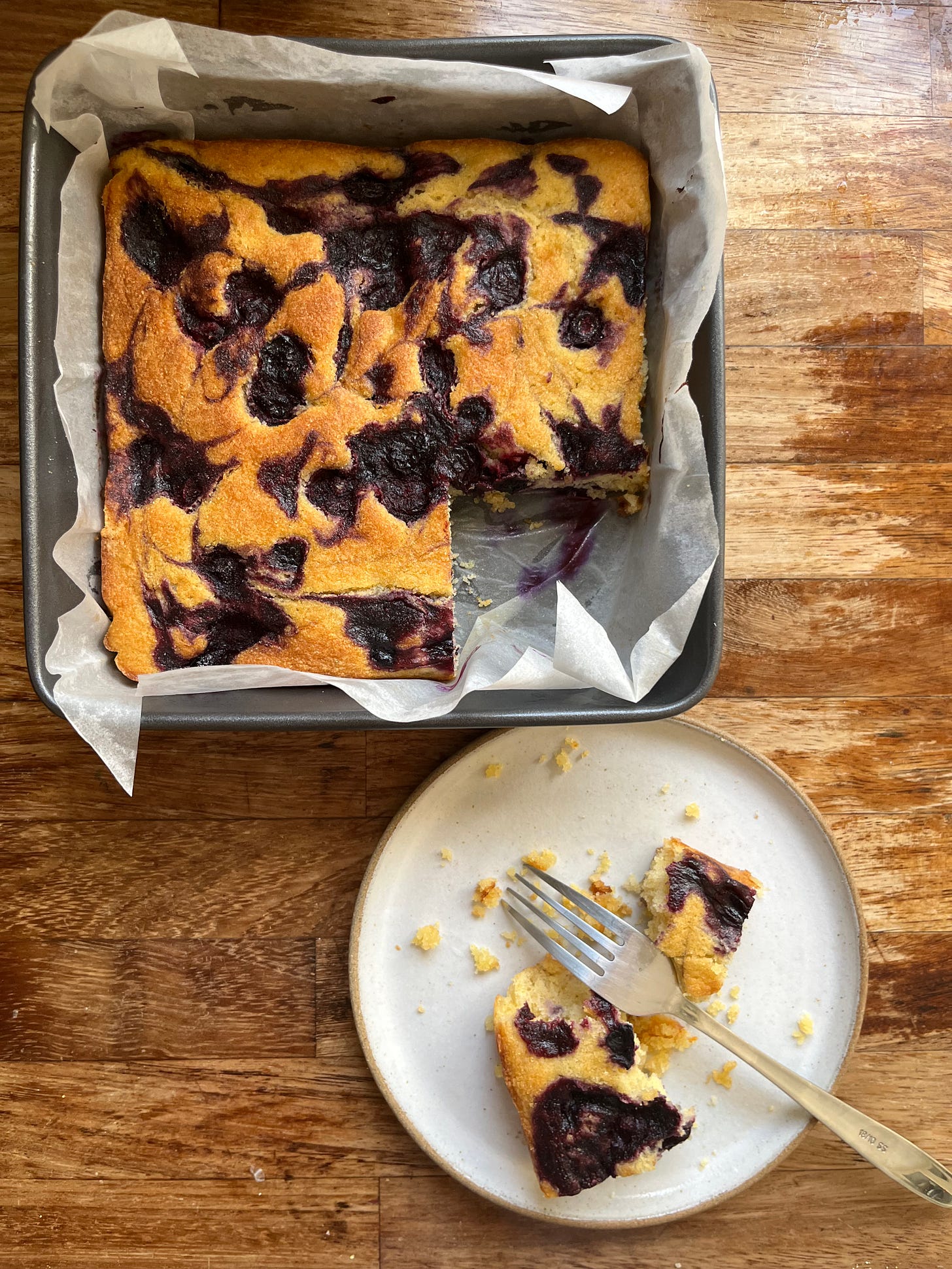
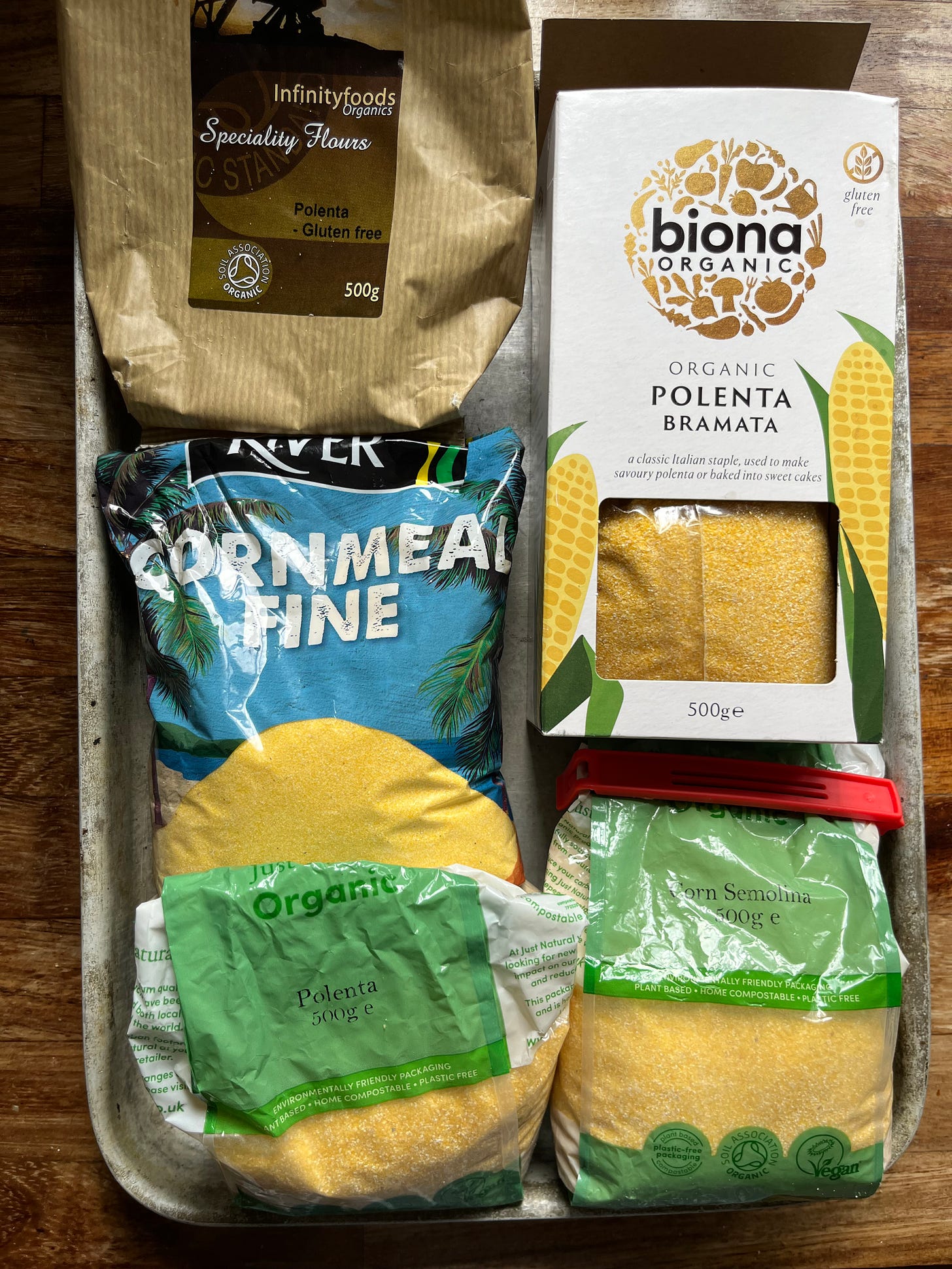


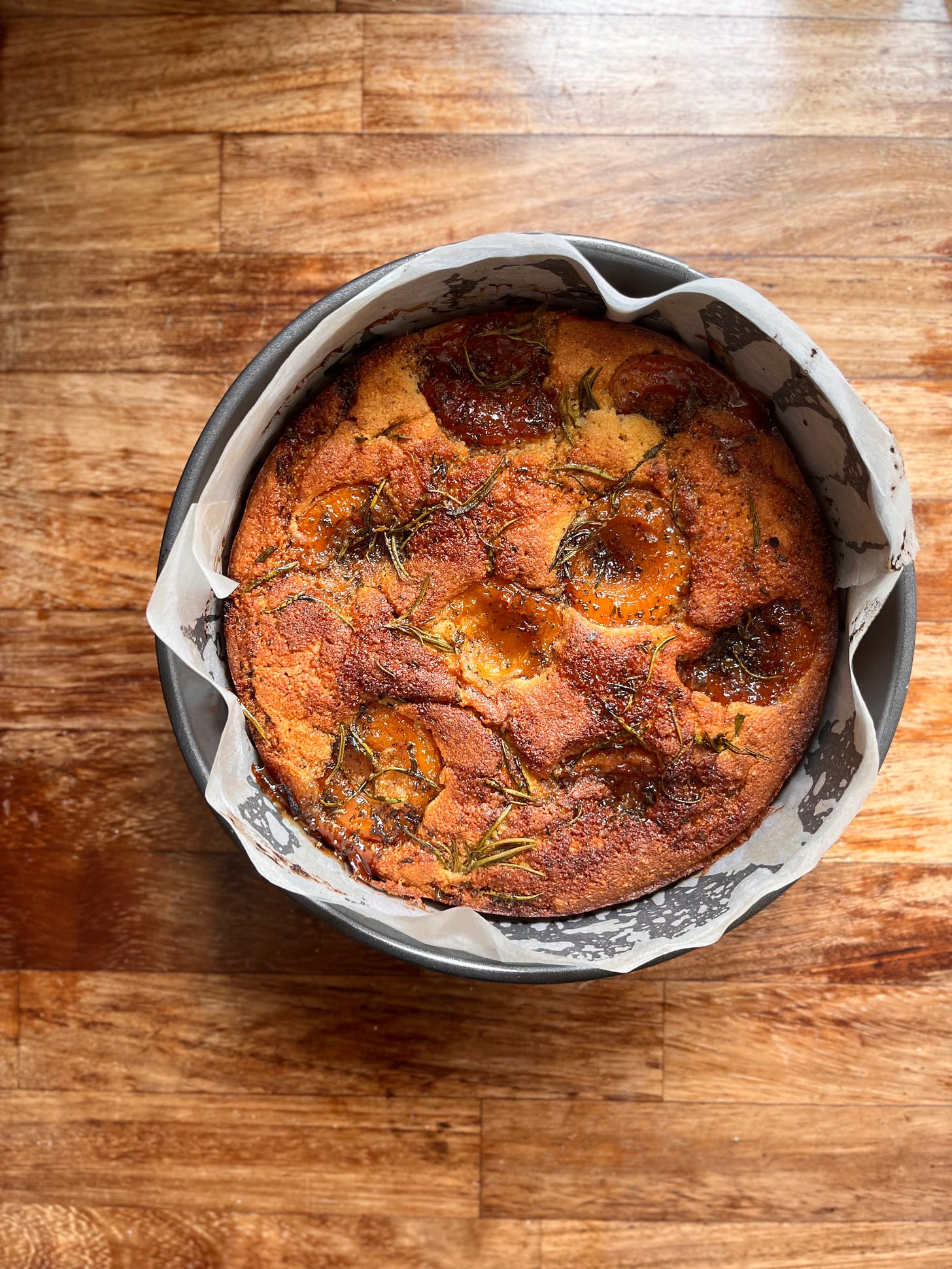


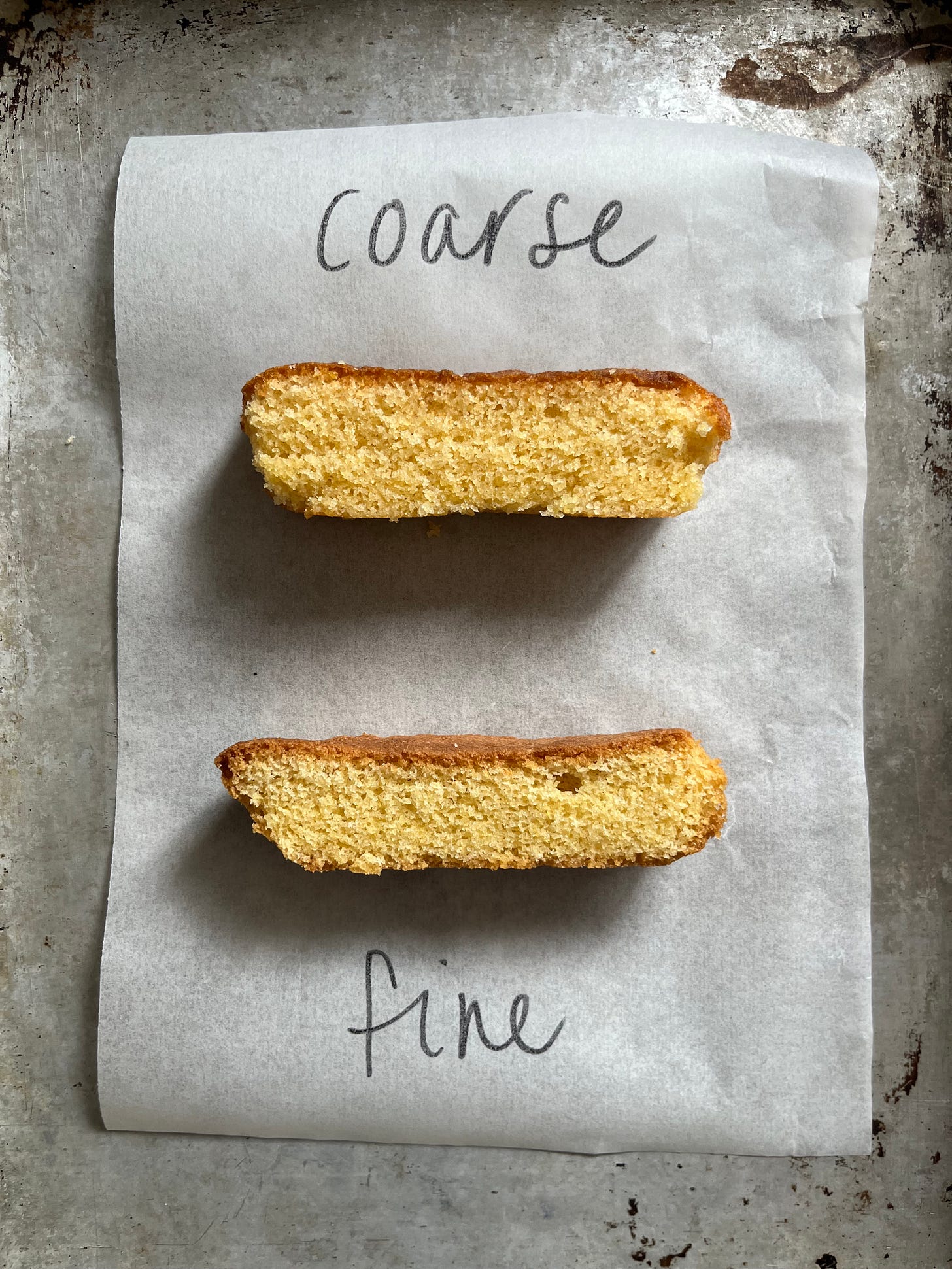

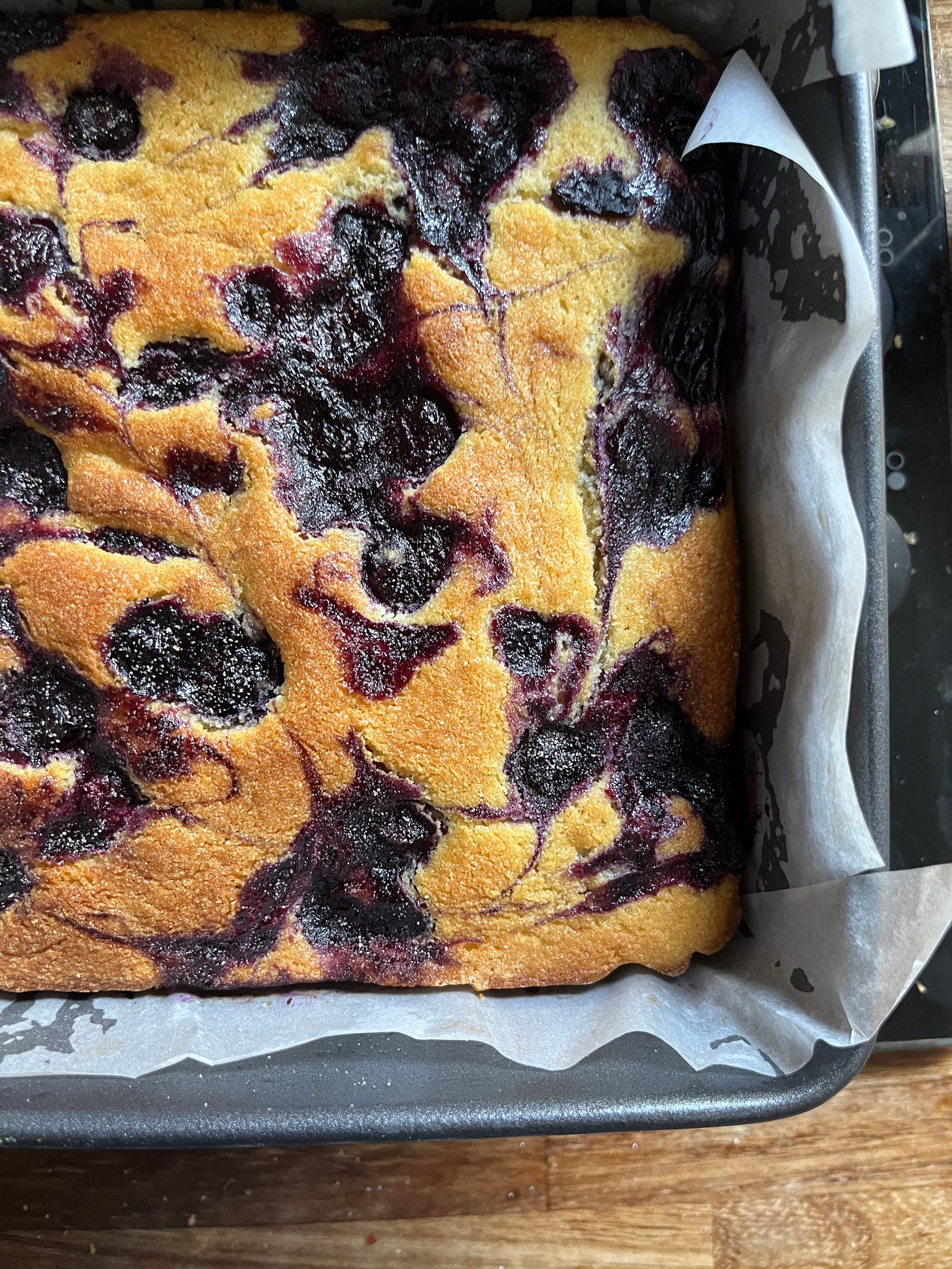


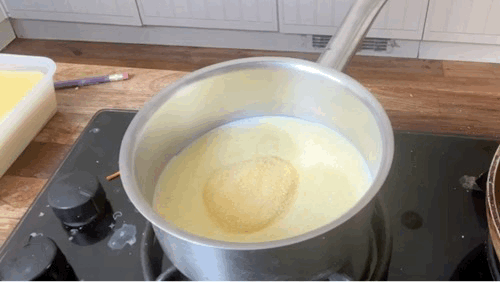
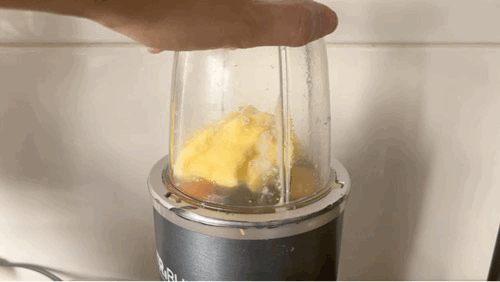
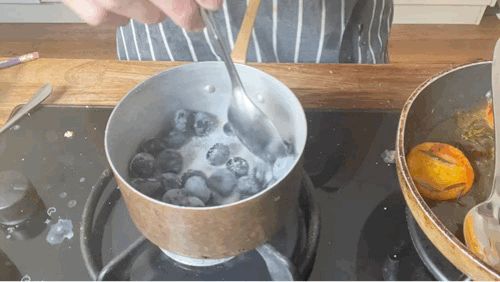

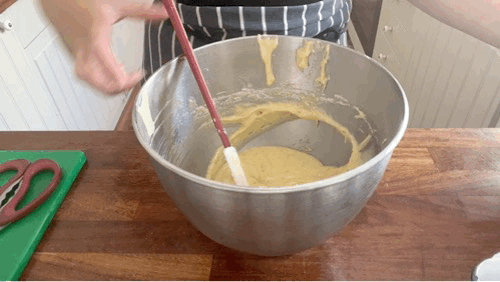
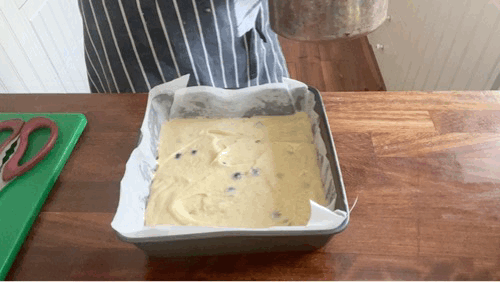
It's CORN! Love this one, as usual, Nic. So much to digest, but one thing that jumped out at me is the blending of the polenta and eggs. I'm often making tangzhongs/scalds that are bouncy and hard to incorporate into the final dough/batter, and often turn to a blender to blitz them smooth. I've been reluctant to call for that in recipes, but if you can, I will too from now on!
I can’t wait to try this cake with blackberries! They grow wild all over Seattle in August. Thank you